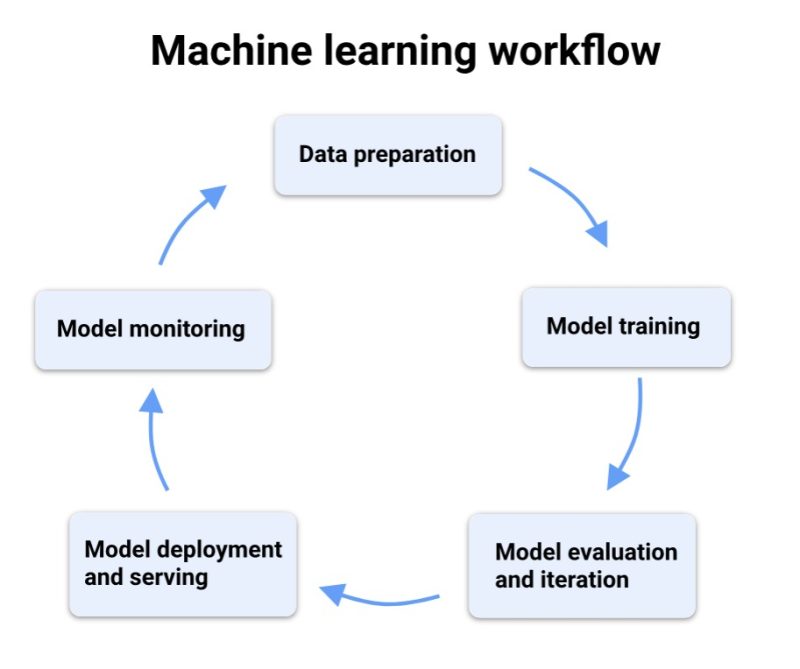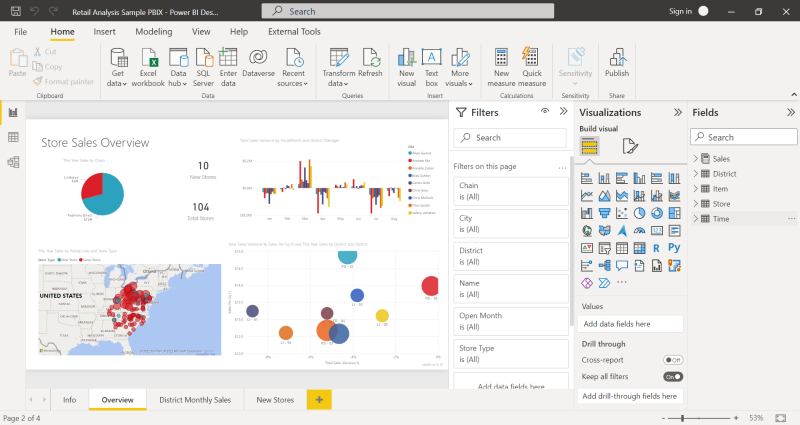AI technology - table of contents
- AI technology for your business - how to prepare for its implementation?
- Define the business problem you want to solve with artificial intelligence
- Define goals and expectations for AI technology implementation
- Learn about the types of AI technologies and their applications
- Prepare your data for AI technology use
- Explore AI implementation options and choose the right method
- Consider the costs and benefits of implementing AI technology
- Prepare for change and monitor the results of AI technology implementation
AI technology for your business – how to prepare for its implementation?
What is worth knowing to aptly modern technologies for the benefit of one’s business? First of all, the fact that not all companies need AI technology at its current stage of development. However, given the pace of development of artificial intelligence, it is worth thinking now about the opportunities it provides for businesses.
Most small businesses relying on a digital presence can already significantly improve business performance by using AI. Larger companies using customer data, planning logistics, or developing modern production lines will also benefit. In other words, almost all companies will soon not do without the help of AI technology if they want to remain competitive. However, where to start?
Define the business problem you want to solve with artificial intelligence
The first step to implementing AI technology in your company is to describe in detail the business problem you want to solve with it. We need to be clear about and understand its relation with our business goals.
Let’s look at the example of a small manufacturing company that is having trouble predicting demand for its products. AI technology can be used to:
- Analysis of current market data,
- Competitive research, and
- Analysis of historical sales trends,
This will make forecasting more accurate for future demand.
A larger institution can do the same. For example, a bank that wants to optimize its lending procedures. It currently applies certain filters to loan applications that automatically reject the riskiest ones. However, the bank still approves too many applications that later face repayment problems.
In both cases, the goal is to create a predictive model that will facilitate planning – identifying potentially bad loans or forecasting seasonal fluctuations in demand. Regardless of the size of the company, in the first step of planning the implementation of AI technology, we need to verify that the customer data we have contains the information needed to solve this particular business problem.
Define goals and expectations for AI technology implementation
Next, it’s a good idea to define data analysis goals that will achieve the business objectives set. The goals should be specific, so use the SMART method, for example. Its name comes from the words specific, measurable, achievable, relevant and timely.
A SMART goal for a small accounting firm introducing AI technology could be as follows: “Automate data entry and analysis within 12 months to reduce customer service time by 50% and improve accuracy by 90%.”
- Specific goals (SMART) are clear and well-defined. For example, instead of the stipulation “we will serve more customers,” a SMART goal specifies what specifically is to be done – automated data entry and analysis – and over what period, within 12 months,
- Measurable goals help us to assess whether a goal has been achieved. For example, the goal “cut customer service time in half and improve accuracy by 90%” is measurable because we can see how performance has improved,
- Achievable goals are realistic in light of the company’s past performance. The goal in the example is achievable if the accounting firm already has the knowledge and experience in data entry and analysis. AI technology can help the company achieve them.
- Relevant goals concern to the company’s strategy outlined in the example and its business goals, as it has in improving productivity and customer service.
- Timely goals have a specific completion date. This makes it easy to assess progress toward them and break them down into manageable sub-goals.
Here, AI technology can help analyze large amounts of data, detect anomalies and ensure accuracy.
With artificial intelligence, we should define measures of success for data analysis (e.g., 90% accuracy of a predictive model) and benchmarks for evaluating success (e.g., reduction in error rates). This will enable us to assess whether the implementation of AI has brought the intended business benefits.
Learn about the types of AI technologies and their applications
There are many AI techniques and tools that help in business. Among the most popular are:
- Machine Learning (ML) – algorithms that learn and improve their performance based on data without the need for explicit programming, an example would be an algorithm that recommends products to customers that may interest them based on their purchase history and preferences,
- Deep Learning (DL) – a more advanced variation of machine learning using artificial neural networks. It is used, among other things, to recognize customers’ faces in a store, allowing personalized service and recommendations.
- Natural Language Processing (NLP) – understanding, interpreting and generating human language in textual or spoken form, used, for example, to create personalized emails to customers,
- Virtual assistants and chatbots – automated systems that conduct conversations in natural language and provide, for example, a voicebot in the customer service department that automatically answers the phone and conducts conversations about the company’s offerings,
- Predictive analysis – building models to predict future events based on historical data, which can be used, for example, to predict customer churn,
- Robotic Process Automation (RPA) – automates repetitive tasks, such as data entry or invoicing,
- Generative AI – to create text, images, voice or video, so you can significantly speed up the creation of marketing materials or generate automatically unique product descriptions for your online store based on images and main features,
A closer look at the capabilities of each of these technologies will ensure that you can select the right AI tools for your company’s specific business problem.
Prepare your data for AI technology use
Small companies often have limited data sets, so getting them right is key. However, even this limited set can be used to train simple AI models. For example, a small online store can use customer purchase data to make personalized product recommendations.
Once you make sure you have sufficient historical data, for example on customer behavior, it is often enough to combine the data you have with ready-to-use AI tools available in the cloud, such as:
- Amazon SageMaker – a platform for building, training and deploying machine learning models,
- Microsoft Azure Machine Learning – a tool for creating and using predictive models,
- Vertex AI Platform – a set of AI and ML tools in Google’s cloud.

Source: Google Cloud (https://cloud.google.com/)
With automation, a company’s internal systems can be integrated with external AI solutions without involving developers to build models from scratch. This significantly reduces costs and speeds up AI implementation.
Explore AI implementation options and choose the right method
Various ways of implementing AI technology in business are possible:
- Development of proprietary AI models and systems by an in-house team of developers and data analysts.
- Outsource the building of dedicated AI solutions to an external company.
- Using off-the-shelf AI models and tools available in the cloud in an “AI as a service” (AIaaS) model
Each of the above methods has its advantages and disadvantages in terms of cost, implementation time or flexibility. However, small businesses should first consider off-the-shelf AI solutions available on the market – such as the aforementioned AWS SageMaker or Vertex AI, which are often more cost-effective and easier to implement, offering ready-to-use predictive models that can be used to analyze customer behavior. And even more specialized tools, such as:
- ClickUp, an AI tool for project management,
- Jasper AI – AI-based assistance in writing marketing materials,
- Microsoft Power BI – one of the best data visualization tools that features AI technology for image recognition and text analysis to discover hidden, valuable information in your data.

Source: Microsoft (https://learn.microsoft.com/)
Consider the costs and benefits of implementing AI
Implementing new technologies always comes at a cost. In the case of AI, the long-term benefits often outweigh the initial costs. However, one must evaluate:
- the cost of developing and maintaining in-house AI systems or using an external AI platform,
- potential savings through automated processes and better decision-making,
- possible increase in revenue due to improved customer service, more relevant recommendations, etc.
- other potential benefits, such as reduced turnaround times and reduced errors.
For example, a small logistics company investing in AI systems to optimize delivery routes can significantly reduce fuel costs and delivery times, which will directly translate into improved customer satisfaction and the ability to serve more trips in the same amount of time.
Prepare for change and monitor the results of AI technology implementation
Implementing new technology requires adaptation. Employees and business processes need to be prepared for it. For example, for a small hair salon, implementing AI technology to manage client scheduling and bookings may require staff training, but in the long run, it can lead to better organization and greater client satisfaction.
It is also worth monitoring the effects of the AI project on an ongoing basis and correcting the course if the results deviate from expectations. Measures such as:
- accuracy of predictive models,
- conversion rates or
- customer satisfaction
They will provide information on whether AI is helping to achieve business goals. They will also allow continuous improvement of AI models to increase their relevance and value to the company.

If you like our content, join our busy bees community on Facebook, Twitter, LinkedIn, Instagram, YouTube, Pinterest, TikTok.
Author: Robert Whitney
JavaScript expert and instructor who coaches IT departments. His main goal is to up-level team productivity by teaching others how to effectively cooperate while coding.
AI in business:
- Threats and opportunities of AI in business (part 1)
- Threats and opportunities of AI in business (part 2)
- AI applications in business - overview
- AI-assisted text chatbots
- Business NLP today and tomorrow
- The role of AI in business decision-making
- Scheduling social media posts. How can AI help?
- Automated social media posts
- New services and products operating with AI
- What are the weaknesses of my business idea? A brainstorming session with ChatGPT
- Using ChatGPT in business
- Synthetic actors. Top 3 AI video generators
- 3 useful AI graphic design tools. Generative AI in business
- 3 awesome AI writers you must try out today
- Exploring the power of AI in music creation
- Navigating new business opportunities with ChatGPT-4
- AI tools for the manager
- 6 awesome ChatGTP plugins that will make your life easier
- 3 grafików AI. Generatywna sztuczna inteligencja dla biznesu
- What is the future of AI according to McKinsey Global Institute?
- Artificial intelligence in business - Introduction
- What is NLP, or natural language processing in business
- Automatic document processing
- Google Translate vs DeepL. 5 applications of machine translation for business
- The operation and business applications of voicebots
- Virtual assistant technology, or how to talk to AI?
- What is Business Intelligence?
- Will artificial intelligence replace business analysts?
- How can artificial intelligence help with BPM?
- AI and social media – what do they say about us?
- Artificial intelligence in content management
- Creative AI of today and tomorrow
- Multimodal AI and its applications in business
- New interactions. How is AI changing the way we operate devices?
- RPA and APIs in a digital company
- The future job market and upcoming professions
- AI in EdTech. 3 examples of companies that used the potential of artificial intelligence
- Artificial intelligence and the environment. 3 AI solutions to help you build a sustainable business
- AI content detectors. Are they worth it?
- ChatGPT vs Bard vs Bing. Which AI chatbot is leading the race?
- Is chatbot AI a competitor to Google search?
- Effective ChatGPT Prompts for HR and Recruitment
- Prompt engineering. What does a prompt engineer do?
- AI Mockup generator. Top 4 tools
- AI and what else? Top technology trends for business in 2024
- AI and business ethics. Why you should invest in ethical solutions
- Meta AI. What should you know about Facebook and Instagram's AI-supported features?
- AI regulation. What do you need to know as an entrepreneur?
- 5 new uses of AI in business
- AI products and projects - how are they different from others?
- AI-assisted process automation. Where to start?
- How do you match an AI solution to a business problem?
- AI as an expert on your team
- AI team vs. division of roles
- How to choose a career field in AI?
- Is it always worth it to add artificial intelligence to the product development process?
- AI in HR: How recruitment automation affects HR and team development
- 6 most interesting AI tools in 2023
- 6 biggest business mishaps caused by AI
- What is the company's AI maturity analysis?
- AI for B2B personalization
- ChatGPT use cases. 18 examples of how to improve your business with ChatGPT in 2024
- Microlearning. A quick way to get new skills
- The most interesting AI implementations in companies in 2024
- What do artificial intelligence specialists do?
- What challenges does the AI project bring?
- Top 8 AI tools for business in 2024
- AI in CRM. What does AI change in CRM tools?
- The UE AI Act. How does Europe regulate the use of artificial intelligence
- Sora. How will realistic videos from OpenAI change business?
- Top 7 AI website builders
- No-code tools and AI innovations
- How much does using AI increase the productivity of your team?
- How to use ChatGTP for market research?
- How to broaden the reach of your AI marketing campaign?
- "We are all developers". How can citizen developers help your company?
- AI in transportation and logistics
- What business pain points can AI fix?
- Artificial intelligence in the media
- AI in banking and finance. Stripe, Monzo, and Grab
- AI in the travel industry
- How AI is fostering the birth of new technologies
- The revolution of AI in social media
- AI in e-commerce. Overview of global leaders
- Top 4 AI image creation tools
- Top 5 AI tools for data analysis
- AI strategy in your company - how to build it?
- Best AI courses – 6 awesome recommendations
- Optimizing social media listening with AI tools
- IoT + AI, or how to reduce energy costs in a company
- AI in logistics. 5 best tools
- GPT Store – an overview of the most interesting GPTs for business
- LLM, GPT, RAG... What do AI acronyms mean?
- AI robots – the future or present of business?
- What is the cost of implementing AI in a company?
- How can AI help in a freelancer’s career?
- Automating work and increasing productivity. A guide to AI for freelancers
- AI for startups – best tools
- Building a website with AI
- OpenAI, Midjourney, Anthropic, Hugging Face. Who is who in the world of AI?
- Eleven Labs and what else? The most promising AI startups
- Synthetic data and its importance for the development of your business
- Top AI search engines. Where to look for AI tools?
- Video AI. The latest AI video generators
- AI for managers. How AI can make your job easier
- What’s new in Google Gemini? Everything you need to know
- AI in Poland. Companies, meetings, and conferences
- AI calendar. How to optimize your time in a company?
- AI and the future of work. How to prepare your business for change?
- AI voice cloning for business. How to create personalized voice messages with AI?
- Fact-checking and AI hallucinations
- AI in recruitment – developing recruitment materials step-by-step
- Midjourney v6. Innovations in AI image generation
- AI in SMEs. How can SMEs compete with giants using AI?
- How is AI changing influencer marketing?
- Is AI really a threat to developers? Devin and Microsoft AutoDev
- AI chatbots for e-commerce. Case studies
- Best AI chatbots for ecommerce. Platforms
- How to stay on top of what's going on in the AI world?
- Taming AI. How to take the first steps to apply AI in your business?
- Perplexity, Bing Copilot, or You.com? Comparing AI search engines
- ReALM. A groundbreaking language model from Apple?
- AI experts in Poland
- Google Genie — a generative AI model that creates fully interactive worlds from images
- Automation or augmentation? Two approaches to AI in a company
- LLMOps, or how to effectively manage language models in an organization
- AI video generation. New horizons in video content production for businesses
- Best AI transcription tools. How to transform long recordings into concise summaries?
- Sentiment analysis with AI. How does it help drive change in business?
- The role of AI in content moderation


















